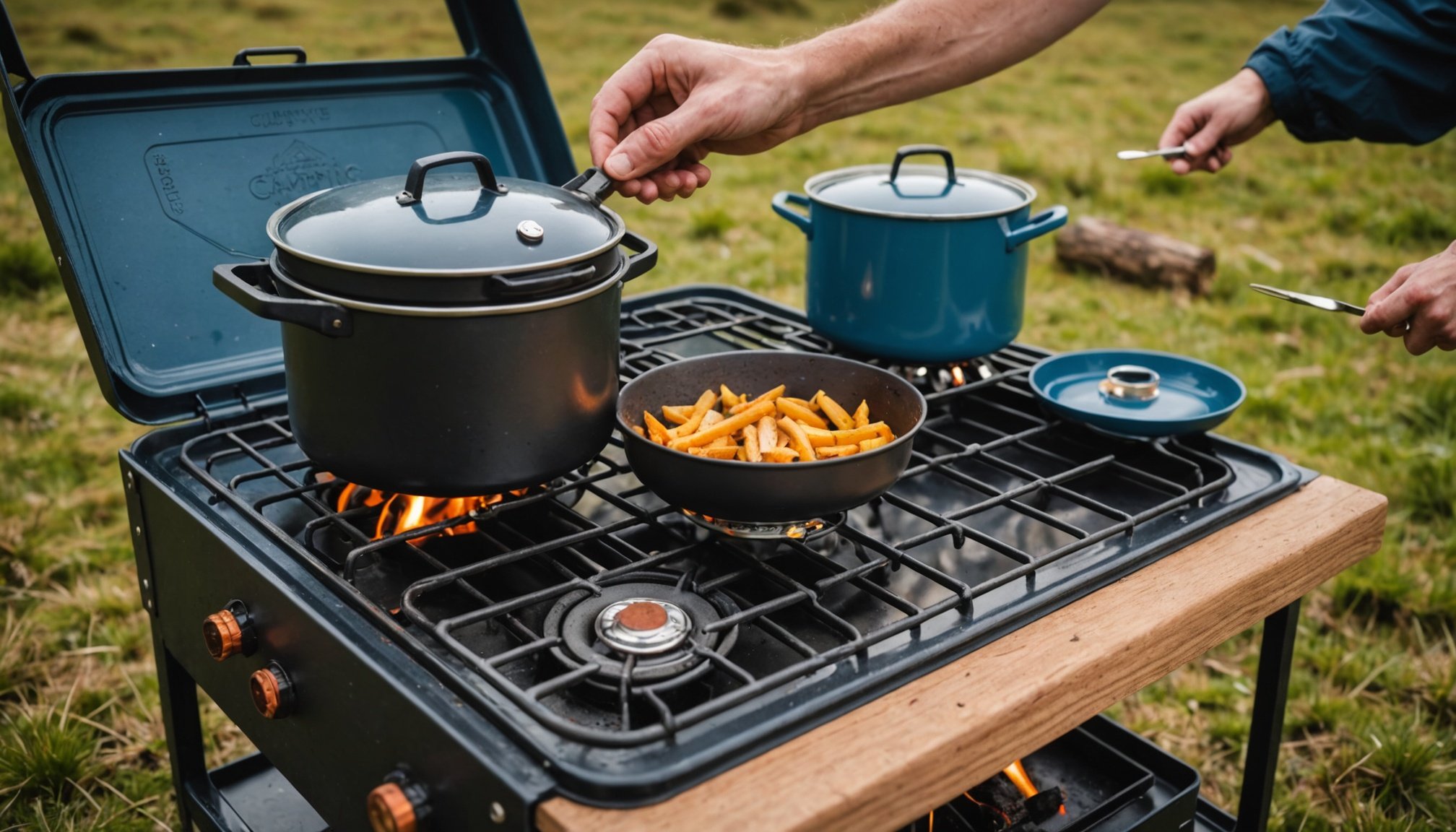Overview of Camping Stoves
Camping stoves are an essential part of any outdoor adventure, providing a reliable means of cooking meals. They are especially valuable in remote locations where access to electricity or traditional cooking equipment is limited. The wide array of camping stoves available in the UK caters to various cooking needs and personal preferences.
There are several types of camping stoves to choose from, each with unique features and benefits. These include canister stoves, liquid fuel stoves, wood-burning stoves, and alcohol stoves. Canister stoves are popular for their ease of use and portability, making them a favorite for quick meals. Liquid fuel stoves offer excellent performance in cold conditions, ideal for winter trips. Wood-burning stoves provide an eco-friendly option, using natural resources for fuel. Lastly, alcohol stoves are lightweight and low maintenance, appealing to minimalist campers.
Also read : Ultimate guide to secure navigation and camping experiences in the breathtaking moorlands of the uk
When selecting a camping stove, several key features should be considered. Portability is crucial; a lightweight stove eases transport. Fuel type affects both convenience and availability, requiring careful selection based on your destination. Stability and wind resistance ensure safe and efficient cooking. Lastly, ease of use is essential for a stress-free outdoor cooking experience, enhancing the overall enjoyment of your adventure.
Best Practices for Using Camping Stoves
When operating camping stoves, certain best practices can enhance safety and efficiency. Conducting pre-use checks is crucial. Inspect your stove for any visible damage, ensure all components are securely attached, and check that fuel lines or canisters are properly connected. This prevents leaks and potential hazards, ensuring a more seamless outdoor cooking experience.
In parallel : Unveil the best uk campsites for enchanting stargazing escapades in dark sky parks
For proper fuel usage, it’s advisable to use only the recommended fuel types for your specific camping stove. Additionally, always store fuel in a cool, ventilated area away from direct sunlight to maintain quality and prevent accidents. Safe storage could potentially extend shelf life and enhance performance during your adventures.
Safety protocols are vital when cooking outdoors. Always set up the stove on a stable, flat surface to prevent tipping. Avoid operating your stove inside tents or enclosed spaces to reduce the risk of carbon monoxide poisoning. Maintain a safe distance from flammable materials, and keep a fire extinguisher or water source nearby to deal with any emergencies swiftly.
Following these protocols not only ensures your safety but can also elevate the overall outdoor culinary experience. Consider keeping a checklist of these best practices to help you stay consistently prepared.
Maintenance Essentials for Camping Stoves
Routine camping stove maintenance is fundamental to ensure longevity and reliable performance. Start by routinely checking all components for wear and tear, particularly focusing on seals and hoses for any cracks or leaks. Regularly clean your camping stove after each trip; accumulated dirt can hinder performance. For cleaning camping stoves, a simple solution is to use warm soapy water and a soft brush to remove debris from burners and other components. Avoid abrasive materials that may damage surfaces.
Deep cleaning procedures vary across different stove types. For canister stoves, disassemble removable parts for a thorough wash. Liquid fuel stoves often require flushing to clear fuel lines. Look for specific cleaning kits suited for your stove model to maintain effective stove upkeep.
Neglect can lead to common issues such as uneven cooking or ignition problems. Address these by ensuring burners are unblocked and functional and the fuel type is as recommended by the manufacturer. Proper maintenance can prevent pressure build-up in fuel canisters—a common safety concern.
Devoting attention to these tasks ensures your camping stove stays in peak condition, providing safe and efficient cooking experiences during all your outdoor adventures. Keeping spare parts and a maintenance kit handy can further enhance preparedness.
Troubleshooting Common Camping Stove Issues
Outdoor cooking can present unique challenges, and camping stove problems might arise even with optimal maintenance. Effective camping stove troubleshooting requires understanding common issues, such as ignition problems. If your stove fails to ignite, ensure that the fuel source is unobstructed. Check that connections are secure and that you’re using the appropriate fuel type.
Uneven cooking is another frequent issue, often caused by clogged burners. If you notice food cooking erratically, cleaning burner components may help restore consistent performance. Uneven flames could also result from improperly placed stove grills or pans. Adjust them to maintain stable and balanced heat distribution across the cooking surface.
Pressure-related problems in fuel canisters might appear as reduced flame output or sputtering. Such issues can sometimes be traced back to temperature changes or faulty canisters. Resolving these requires storing canisters in temperatures that match the manufacturer’s guidelines and ensuring they are not damaged.
By understanding these common issues and effective resolving stove issues strategies, campers can prepare for and address challenges swiftly, ensuring a safe and enjoyable cooking experience. Always keep a basic toolkit and replacement parts within reach for quick on-site fixes.
Comparison of Camping Stove Brands in the UK
Navigating the diverse market of camping stoves can be a daunting task, especially with various brands making their presence in the UK. It’s essential to explore different features, prices, and user feedback to select the right stove. Some of the best camping stove brands in the UK include Trangia, Campingaz, and Coleman, each offering unique advantages.
Trangia stoves are well-regarded for their simplicity and durability, ideal for those seeking a dependable and straightforward solution. Their all-in-one design is perfect for minimalist campers. In contrast, Campingaz stoves focus on convenience and accessibility. Their products are known for easy setup and compatibility with multiple fuel sources, making them versatile for various camping environments.
Coleman stoves provide a robust choice, renowned for their high performance and rugged designs. These stoves are particularly favoured for longer camping trips where reliability is crucial. Price-wise, Trangia tends towards the budget-friendly end, while Coleman might require a more significant investment but offers more features.
Offering tailored recommendations, experienced campers might enjoy Coleman’s durability, while beginners could benefit from Campingaz’s simplicity. Trangia remains an excellent choice for budget-conscious adventurers. These insights aid in making informed decisions, ensuring every camper finds the perfect match for their specific needs.
Safety Regulations and Guidelines
Navigating the use of camping stoves effectively requires a grasp of camping stove safety and understanding the relevant safety regulations in the UK. Equipping yourself with this knowledge ensures both compliance and safe usage while enjoying the outdoors.
In the UK, camping regulations stipulate certain guidelines related to the safe operation of camping stoves. It is imperative to know local fire restrictions and zones where open fires, including gas stoves, may be banned. Before setting out, familiarize yourself with these rules by checking governing bodies like the local council or forestry services.
To comply with camping stove safety standards, ensure your stove is used in open spaces to avoid the risk of carbon monoxide poisoning. Additionally, maintaining a clear perimeter free from flammable debris enhances safety.
Emergency procedures form a crucial component of safe camping. Always have a basic fire extinguisher and first-aid kit on hand. Being prepared with knowledge about extinguishing small fires can make a significant difference in an emergency.
Carrying proper safety gear such as heat-resistant gloves and safety goggles can also protect against unforeseen accidents. By embracing these safety measures, campers can enjoy memorable and secure adventures.











